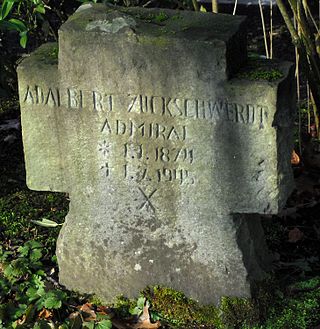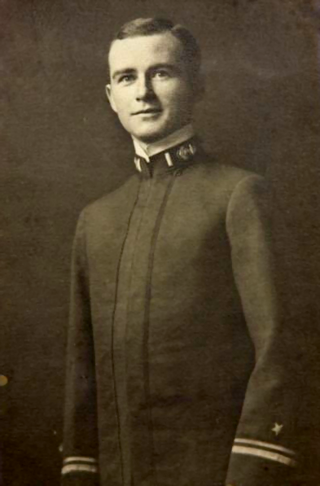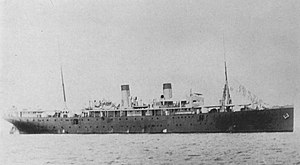
Apra Harbor, also called Port Apra, is a deep-water port on the western side of the United States territory of Guam. It is considered one of the best natural ports in the Pacific Ocean. The harbor is bounded by Cabras Island and the Glass Breakwater to the north and the Orote Peninsula in the south. Naval Base Guam and the Port of Guam are the two major users of the harbor. It is also a popular recreation area for boaters, surfers, scuba divers, and other recreationalists.

A ship is scuttled when its crew deliberately sinks it, typically by opening holes in its hull.

The German East Asia Squadron was an Imperial German Navy cruiser squadron which operated mainly in the Pacific Ocean between the mid-1890s until 1914, when it was destroyed at the Battle of the Falkland Islands. It was based at Germany's Jiaozhou Bay Leased Territory in China.

During World War I, conflict on the Asian continent and the islands of the Pacific included naval battles, the Allied conquest of German colonial possessions in the Pacific Ocean and China, the anti-Russian Central Asian revolt of 1916 in Russian Turkestan and the Ottoman-supported Kelantan rebellion in British Malaya. The most significant military action was the careful and well-executed Siege of Qingdao in China, but smaller actions were also fought at Bita Paka and Toma in German New Guinea.

SMS Cormoran or SMS Cormoran II was a German armed merchant raider that was originally a German-built Russian merchant vessel named Ryazan. The ship was active in the Pacific Ocean during World War I. Built in 1909, she was captured by the German light cruiser SMS Emden on 4 August 1914 and converted into a raider at the German colony Kiautschou. She was forced to seek port at Apra Harbor on the US territory of Guam on 10 December 1914. The United States, then declared neutral in the war, refused to supply provisions sufficient for Cormoran to make a German port. After the US declaration of war on April 6, 1917, the Naval Governor of Guam informed Cormoran that she would be seized as a hostile combatant, prompting her crew to scuttle her.

Adalbert Zuckschwerdt was captain (Korvettenkapitän) of the German raider SMS Cormoran, which sailed from the German Colony of Qingdao, China, until she was finally docked and interned at Guam by the Americans. Zuckschwerdt preempted the confiscation of his ship by the Americans by igniting preplanted explosives and scuttling her in Apra Harbor. Seven of the German sailors on board died, and Zuckschwerdt spent the rest of the war as a POW.

The Dresden class was a pair of light cruisers built for the Imperial German Navy in the early part of the 20th century. The class comprised SMS Dresden, the lead ship, and SMS Emden. Both ships were laid down in 1906; Dresden was launched in 1907, and Emden followed in 1908. They entered service in 1908 and 1909, respectively. The design for the ships was an incremental improvement over the preceding Königsberg class, being slightly larger and slightly faster, but with the same primary armament of ten 10.5 cm (4.1 in) guns. Dresden and Emden were powered by steam turbines and triple expansion engines, respectively, as part of continued experiments with the new turbine technology.

SMS Kaiserin Elisabeth was a Kaiser Franz Joseph I-class protected cruiser of the Austro-Hungarian Navy. Named in honor of the Empress Elisabeth, consort of Emperor Franz Josef, the cruiser was designed for overseas service and in fact was stationed in China at the outbreak of World War I in 1914.

The Battle of Más a Tierra was a World War I sea battle fought on 14 March 1915, near the Chilean island of Más a Tierra, between a British squadron and a German light cruiser. The battle saw the last remnant of the German East Asia Squadron destroyed, when SMS Dresden was cornered and scuttled in Cumberland Bay.

SS Illinois was an iron passenger-cargo steamship built by William Cramp & Sons in 1873. The last of a series of four Pennsylvania-class vessels, Illinois and her three sister ships—Pennsylvania, Ohio and Indiana—were the largest iron ships ever built in the United States at the time of their construction, and amongst the first to be fitted with compound steam engines. They were also the first ships to challenge British dominance of the transatlantic trade since the American Civil War.

USS Supply, ex-Illinois, was a schooner-rigged iron steamer built in 1873 by William Cramp & Sons of Philadelphia. Illinois was purchased by the Navy Department from the International Navigation Company on 30 April 1898 for $325,000.00 and commissioned as Supply, Lt. Comdr. R. R. Ingersoll in command.

William John Maxwell was a United States Navy officer who served as the 18th Naval Governor of Guam. He entered the United States Naval Academy in 1874, but was not commissioned as an ensign until 1883. He served aboard many ships before becoming one of the inaugural members of the General Board of the United States Navy. Afterward, he commanded both USS Mississippi and USS Florida.

United States Navy operations during World War I began on April 6, 1917, after the formal declaration of war on the German Empire. The United States Navy focused on countering enemy U-boats in the Atlantic Ocean and the Mediterranean Sea while convoying men and supplies to France and Italy. Because of United States's late entry into the war, her capital ships never engaged the German fleet and few decisive submarine actions occurred.

William Pigott Cronan was a United States Navy captain who served as the 19th Naval Governor of Guam. During his tenure in the Navy, he became decorated, commanded a number of ships, and came to be known as "the most popular man in the Navy". He participated in the Battle of Santiago de Cuba during the Spanish–American War. In 1903, he gained some attention for his participation in the rescue of a Venezuelan fisherman off the coast of La Guaira under bad conditions. Both the Venezuelan government and navy command praised him for the way he carried out the operation. He became a national news story in 1907 while serving aboard USS Connecticut during a training operation. When a gun nearly exploded because of leaking powder; he shoved his hand into the gun's breechblock, preventing the explosion and losing two of his fingers in the process.

The German commerce raiders of World War I were surface vessels used by the Imperial German Navy for its Handelskrieg, a campaign against Allied seaborne trade. The ships comprised warships, principally cruisers, stationed in the German colonial empire before the war began, express liners commissioned as auxiliary cruisers and later, freighters outfitted as merchant raiders. These vessels had a number of successes and had a significant effect on Allied naval strategy, particularly in the early months of the war.

The Tokai Maru was a Japanese passenger-cargo ship built by the Mitsubishi Heavy Industries shipyard that was sunk in Apra Harbor, Guam, in 1943, during World War II.

SMS Emden was the second and final member of the Dresden class of light cruisers built for the German Kaiserliche Marine. Named for the town of Emden, she was laid down at the Kaiserliche Werft in Danzig in 1906. The hull was launched in May 1908, and completed in July 1909. She had one sister ship, Dresden. Like the preceding Königsberg-class cruisers, Emden was armed with ten 10.5 cm (4.1 in) guns and two torpedo tubes.

SMS Cormoran was an unprotected cruiser of the Bussard class, the fifth member of a class of six ships. She was built for the Imperial German Navy for overseas duty. The cruiser's keel was laid down in Danzig in 1890; she was launched in May 1892 and commissioned in July 1893. Cormoran was armed with a main battery of eight 10.5-centimeter (4.1 in) guns, and could steam at a speed of 15.5 knots.



















